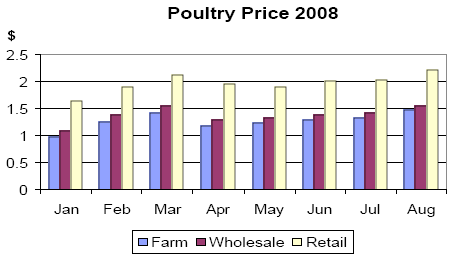



Peru: Agricultural Situation: Poultry Update 2008
USDA Foreign Agricultural Service GAIN Report by Gaspar E. Nolte. A link to the full report is provided. The focus is on price trends. Poultry production is expected to increase by 6 per cent this year but even this will not match demand, which is growing at an annual rate of 11 per cent.Report Highlights
Retail poultry price has increased 40 per cent since January 2008. This increase is due to high corn prices and strong demand.
The monthly inflation rate for August 2008 is estimated in 0.6 per cent, 7 per cent higher than the previous month and significantly higher than the 0.14 per cent in August 2007. This is a January to August inflation rate of to 4.69 per cent. Though the Peruvian Central Bank has not revised its 5 per cent forecast for calendar year (CY) 2008 yet, it seems that this goal may be falling out of reach.
Poultry is a staple product in the Peruvian diet and an important component of the “basic basket” used to measure inflation. Chicken meat prices increased 7 per cent in August 2008, contributing 42 per cent to the month’s inflation. Since last June, chicken meat price has increased 16 per cent. This situation has taken the government to take a close look at poultry production costs and prices to keep this chicken-dependent inflation under control.

Current chicken prices are at around $2.37 per kilo, 40 per cent higher than its historical price. Prices began increasing in 2007 as corn prices started sky rocketing. Landed corn prices have double since last October. Since corn is 75 per cent of the total chicken cost, this increase has created a major disruption in the cost structure of producers. However, corn is not the only factor pushing chicken prices up. Increased demand due to more disposable income as a result of an expanding economy is also pushing chicken prices and thus, fueling inflation.
The poultry industry is expected to grow 6 per cent this year. However demand will outpace it with an 11 per cent increase. According to the National Statistical Service, Peruvians spend 10 per cent of their food money on poultry, which explains why it is so important for the government to keep a close eye on the poultry industry. Currently, Peru produces 33 million birds per month and annual per-capita consumption is 29kg.
The Ministry of Agriculture, attempting to reduce or at least keep prices steady, has been evaluating importing chicken leg quarters from Brazil or the US. This initiative has encountered two major obstacles: first, the Peruvian chicken market is broadly fresh and second, c.i.f. prices are around $2.36 per kilo, which leaves no room for marketing and distribution expenses, let alone profit.
Further Reading
| - | You can view the full report by clicking here. |











